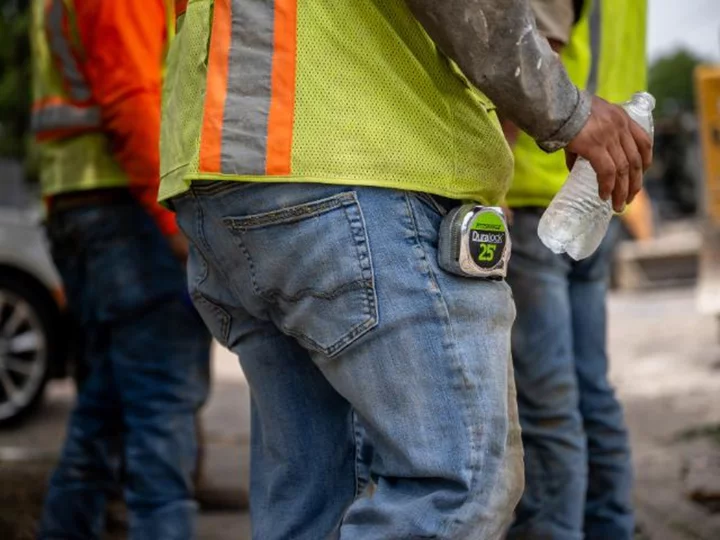A record heat wave stretching from California to Florida has caused dozens of deaths, filled some hospitals to pandemic levels and prompted government warnings about avoiding extended exposure to heat. But the federal agency charged with protecting you on the job can do little or nothing if your boss orders you to work outside in the searing summer sun.
The Occupational Safety and Health Administration, or OSHA, is only now in the process of drafting a heat standard for work places, even as climate change means such extreme weather will likely grow more common. That effort, announced by the Biden administration nearly two years ago, is likely years from taking effect, if it does go into effect at all.
Business interests, including the US Chamber of Commerce, are objecting to the rule making proposal, saying the question of what heat conditions are safe for workers is a complex question not easily addressed by a set of standards and rules and that differences in exertion and physical condition of workers plays a role in the risk from heat.
But labor groups say that formal standards on excessive heat are long overdue.
"The need for enforceable standards to ensure employers are implementing the proper controls to protect workers in high-heat conditions is greater than ever," said a 2022 letter on the topic from the AFL-CIO. "As the global temperature rises, workers are even more at risk for occupational heat exposures."
Heat deaths on the job
What is clear is that workers are dying on the job due to exposure to high heat.
The Bureau of Labor Statistics lists 436 workplace deaths between 2011 and 2021 due to exposure to high heat in the work place, or roughly 40 a year. Since most of those occurred in the summer that's well over a death a week on the job for workers exposed to heat during the hottest months.
And experts say those numbers grossly underestimate the number of actual deaths from heat exposure on the job.
"Heat illness interferes with cognitive ability. People suffering may make more mistakes due to the high heat. That won't go down as a heat-related illness if you get run over by a vehicle or crash it, but it was caused by the heat," said Jordan Barab, who served as deputy assistant secretary of OSHA from 2009 to 2017. "You have workers listed as dying from natural causes, such as heart attacks, or going home suffering from the heat, getting sick and dying there, and it might not be counted as work related."
Eugene Gates, Jr., a 66-year old letter carrier in the Lakewood Post Office in Dallas, collapsed in a front yard on his route and died on June 20. The National Weather Service recorded a high temperature of 97 degrees at the Dallas Love Field airport that day. But the heat index, which can be a better gauge of how hot it feels, reached about 115 that day, according to National Weather Service data tracked by Wunderground, a weather website.
There is still no official autopsy report, and his death has not been officially classified as heat-related, said his widow, Carla Gates. She said she has asked the US Postal Service for answers around her husband's working conditions and death that day.
"It most definitely was the heat. He had no health problems whatsover," she told CNN. And she said her husband was never one to complain about the heat he regularly faced on his route.
"He'd say, 'Baby I'm used to it, I know what to do,'" she said.
Kimetra Lewis, president of the National Association of Letter Carriers branch that represented Gates, said she's aware of numerous other letter carriers who have had been overcome by the heat on the job during the recent heat wave. "Heat is a serious safety issue," she said.
The postal service said it is "saddened" by Gates' death, and while it didn't say whether his or other deaths over the years are heat related, it acknowledged the risk that heat poses.
"Our carriers deliver the mail throughout the year during varying temperatures and climatic conditions. This includes during the summer months when temperatures rise throughout the country. The safety of our employees is a top priority," said the USPS statement in response to questions about his death.
How heat can kill on the job
Heat stroke is a deadly condition in which the body's core temperature can rise above 104 degrees, said W. Larry Kenney, professor of physiology and kinesiology at Penn State. The rise in body temperature that follows can cause the brain cells to have trouble sending needed signals to the body and trigger massive failure of vital organs such as the heart, kidneys and liver.
"Heat stroke is a life-threatening emergency that causes some form of cognitive dysfunction," said Kenney. Most people who die from it succumb to a combination of high core body temperature and heart failure. Exertion in those conditions can significantly increase the risk.
Many of the heat-related work deaths are in outdoor occupations such as construction, agriculture and delivery services. But indoor work places lacking air conditioning, such as in many warehouses, can also place workers at risk.
Even if indoor jobs avoid direct sun exposure, the possible lack of a breeze can lead to less sweat evaporation. The human body's primary way to deal with high heat is through sweating, which cools the body when it evaporates. But if high humidity or lack of a breeze limits that evaporation, then sweat only causes dehydration without helping to cool the body, Kenney said.
Even non-fatal heat stroke can cause permanent damage to vital organs and lifelong medical issues.
And the problem of extreme heat is getting worse in the face of climate change. There have already been more than 2,300 heat records set in the United States alone during the recent heat waves, and the world has experienced its hottest day on record earlier this month.
And climate study groups are forecasting that things will get worse in the coming years. A study last year by the First Street Foundation estimated that the number of US residents facing at least one day with a heat index over 125 degrees, considered extremely dangerous, will grow from 8 million this year to more than 100 million by 2053.
But despite these risks, getting a clear set of rules to protect workers from high heat has proved difficult.
OSHA heat safety rules
Even without a specific heat standard, OSHA can fine employers that let heat get unsafe for workers under a "general duty" rule requiring safe work places.
For that to happen, OSHA has to show that there is a serious hazard that can cause death or serious harm, that the hazard is widely recognized, and that there is a feasible means of abatement, former OSHA official Barab said.
"The problem with using a general duty clause, it gets complicated. Did the worker have a pre-existing condition? Is 100 degrees considered dangerous? What are feasible means of abatement? OSHA has had numerous heat citations overturned," he said. "That's why a heat standard would be much more useful."
OSHA said protecting workers from heat is a major priority.
"We know that extreme heat is a long-term problem and recognize the urgency to address its immediate impacts," said a statement from OSHA Assistant Secretary Doug Parker. "An OSHA regulation on heat will provide the agency with additional tools to enforce requirements in workplaces where employers are putting workers at risk."
The Chamber of Commerce insists it wants to protect workers. But it says having OSHA come up with a clear, effective standard that can be followed by employers will be difficult, considering all the different factors involved.
"The heat issue is one that is not going away as a hazard," said Marc Freedman, the Chamber's vice president of work place policy. "The chance of OSHA moving forward on a regulation about heat exposure is very high. I would say it's a reasonable to expect a proposed rule in the next 12 months."
But there's a long path from a proposed rule to one on the books. And while the Biden administration is on record favoring an OSHA heat standard, a pro-business Republican president might kill the chances for its getting on the books for years, if not decades, to come, according to Barab.
"It can take 16 or 20 years to put an OSHA rule in place," he said "Even in the best circumstances, it be can five to seven years."
-- CNN's Angela Fritz contributed to this report.









